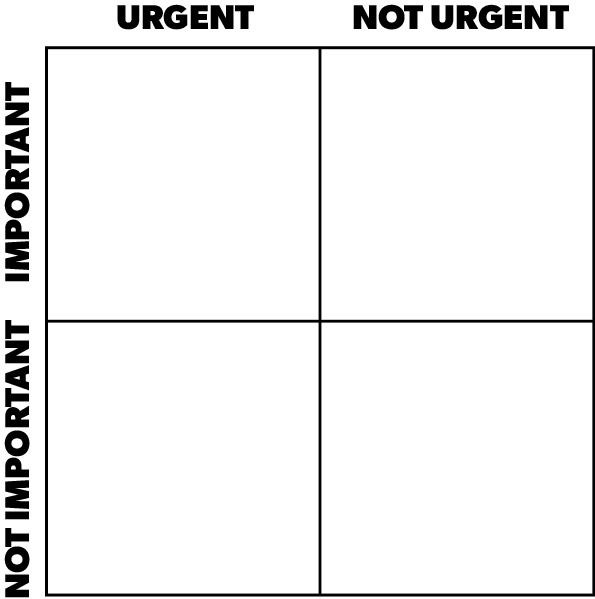5 Simple Steps for Successful Time Management for Entrepreneurs
9 Min Read | Nov 7, 2024

Being busy is natural when you lead a business. The question is, are you busy doing the right things? Sure, you’re hustling to build your brand, serve your customers, and grow your company, but a whole lot of other stuff competes for your time. Maybe even stuff that seems earth-shaking that only you can fix. But here’s the thing: If you treat everything like it’s urgent and important, nothing really is. You’re just neglecting the things you want and need to do most—and that’s a fast track to burnout.
But that doesn’t have to be your story. No, you can’t add more hours to your day—but you can shift your mindset and priorities so you’re working way smarter, not just harder. That frees you up to work on your business, not just in it, with time and energy left over to go for a run, make it to your kid’s school play, or finally go on that date you keep rescheduling.
Don’t worry—we’re not suggesting you enroll in a fancy course on time management for entrepreneurs. But we do have some leader-tested time management hacks that will help you master your days so you ultimately get more out of life.
These five steps (focused on time management for entrepreneurs and small-business leaders alike) will help you take back control of your schedule.
Step 1: Imagine What You Would Do With More Time
Before you dive into the nuts and bolts of time management for business owners and other leaders, put on the brakes for just a minute. Take a second to imagine a workweek that’s under control—a week of strategy, margin and sanity. To really get a picture of what that would look like, write down your answers to these three questions:
- What would you do if you had more time?
- What would having more time mean to you?
- What’s holding you back from having time to do those things?
The next few steps we’ll walk through will show you what’s really holding you back and help you make a plan to overcome it. Keep going!
Related articles:
27 Work-Life Balance Quotes for Motivation and Wisdom
Vision Casting: 7 Reasons Why It Matters
Ready to get time back on your side?
A business leader like you shouldn’t feel pulled apart by a dozen different priorities. Download the Ultimate Guide to Time Management to get your business week back under control.
Step 2: Complete a Time Audit
These are the most common time-sucking activities most workers say they deal with every day.1
- Trying to multitask
- Fielding interruptions like emails, chats, phone calls, texts and office drop-ins
- Doing other people’s work
- Focusing on the wrong priorities
- Being bombarded with emergencies (that often aren’t actually emergencies)
No wonder 3 in 4 workers in the U.S. feel burned out at least sometimes.2 And 42% of small-business owners have experienced burnout in the past year.3 That really does suck! How much of your day is being stolen by these time-wasters? The only way to know for sure is with a time audit.
Related articles:
Small-Business Labor Crisis Report 2023
How to Create Role Clarity Using Key Results Areas
How to Do a Time Audit
Using a time tracker with spaces for 15-minute increments of every hour of your day, log everything you do for one week. Yes, everything—answering texts and emails, leading meetings, having hallway conversations, all the things start to finish each day, in real time.
You probably thought running a business sounded fun—until you realized it would actually run you. Discover the EntreLeadership System—the small-business road map that takes the guesswork out of growth.
Pro tip: Take your time tracker—a good old-fashioned notebook—with you everywhere and track your time as you go. Don’t try to remember what you did and record it all at the end of the day. Just note every block in your time audit as it happens.
Once you see what’s really happening every day, you can fix it.
Step 3: Discover Your Most Productive Time of Day
Ever heard of the 80/20 rule (also called the Pareto Principle)? It’s the idea that just 20% of your work generates 80% of your results.4 Said another way, when you focus 80% of your effort on the 20% of activities that matter most to growing your business and staying healthy personally, you get more done and feel better.
Related article: 11 Productivity Tips for Small-Business Owners: Manage Your Day and Your To-Do List
With that in mind, it’s time to take a look at your time audit.
How to Review Your Time Audit
Grab your highlighters and get ready to color your time audit to uncover your most productive time of day (and your least).
- Use one color to highlight where you were productive and in your flow.
- Use another color to highlight where you were interrupted, distracted or struggling with flow.
- Use a third color to star the time blocks where you wish you were doing something else.
Now study your patterns.
- What were you doing when you felt in the zone? Was your work creative, tactical or planning-focused? Were you alone or with others? Consider what work flows naturally. (These are your sweet spots.)
- What necessary tasks did you struggle to complete?Is it because you don’t like them, you’re not good at them, or both?
- Now look for your energy patterns in the morning, midday and evening. Did creative planning on Monday morning fly by but drag when you picked it up again Wednesday afternoon? You might be more creative in the morning.
- Finally, consider inefficiencies. Did you make six trips to Home Depot throughout the week when you could’ve grouped them into three? Did you respond to emails throughout each day instead of handling them at just a few set times?
Once you complete Step 3, you’ll have a clear picture of what’s filling your day and how those activities make you feel. The million-dollar question now is this: Are your minutes adding up the way you want them to? As you carefully prioritize tasks, they will.
Related article: How to Improve Your Decision-Making Skills
Step 4: Prioritize Tasks
Ever get to the end of an exhausting day and wonder what you even got done? Understatement, right? Plenty of activities can keep you up to your eyeballs in “busy” and still not move you toward professional and personal growth. In his book The 7 Habits of Highly Effective People, Stephen Covey showed us how to plot our tasks in a time management quadrant (also called an Eisenhower Matrix). Here’s how it works:
Everything you do, every task you complete falls into one of these four categories:
- Important and urgent
- Important but not urgent
- Not important but urgent
- Not important and not urgent

How to Do Your Time Management Quadrant
To pinpoint your time suckers and the wins you want to repeat, plug the activities you logged during your time audit into the time management quadrant. Here’s what that could look like:
Important and urgent: Things to do now or soon
Examples: Doing payroll, finding cover for a team member who called out, and handling a family emergency
Important but not urgent: Things to delay or plan
Examples: Going for a run, planning next quarter’s business goals, meeting with your CFO about your retained earnings targets, and taking your spouse to dinner
Not important but urgent: Things to delegate
Examples: Answering constant texts and emails, doing your bookkeeping, and putting our fires someone else should put out
Not important and not urgent: Things to drop or delete
Examples: Talking about last night’s game for 20 minutes at the coffee station, scrolling social media throughout the day, and unwinding every night with hours of mindless TV
Now you’re ready to move to the fun part—reimagining your schedule!
Related article: How to Delegate to Your Team (With Red-Hot Confidence)
Step 5: Create a Weekly Schedule
The saying goes: Tell your day where to go or you’ll wonder where it went. So, now that you’re clear on the types of tasks filling your schedule, you’re ready to tell them where they really belong! In other words, it’s time to create a weekly schedule and plan your calendar strategically.
Pro tip: Before you create your new schedule, take a hard look at time suckers you need to completely delete from your day—and your habits. Also, go back to Step 1 and remember to build in time for what’s really most important to you.
Now, start with a fresh planner and schedule everything you want in your daily or weekly rhythm. Here’s what that means:
- Focus first and most on Quadrants 1 and 2. (You’ll see your satisfaction and quality of life go way up!)
- Block time for nonnegotiable things like important meetings, deadline-driven projects, and all the must-do activities that only you can do.
- Challenge yourself to include important activities that are easily pushed to the side. Go ahead—block that time to brainstorm, plan, enjoy a family movie night, and start your day with a walk and quiet time.
- Finally, add in things that matter but tend to derail you—like checking email and texts and returning calls. Block time to update your schedule and even open-door time for team members to stop by with quick questions and ideas.
All this scheduling might feel weird at first. You’ll have to train yourself—and your team members—to uphold your new system, but intentionality is how you stay on top of the time priorities you listed in Step 1.
Related articles:
How Keystone Habits Can Improve Your Life
Your Guide to Strategic Planning That Boosts Your Business
What’s Next: Take Control of Your Workweek
Working your new plan faithfully is how you take control of your workweek. Don’t sweat it when distractions happen. That’s called life. Just handle interruptions as quickly as possible and move back to your list. Keep your priorities, time audit and time management quadrant handy to help you see where you’ve been, what you never want to go back to, and where you’re going.
Need some extra help getting your time under control? Check out the free EntreLeadership Ultimate Guide to Time Management. The principles and action steps you’ll find helped Dave Ramsey grow his small business into a national brand that gives hope to millions of people globally.

